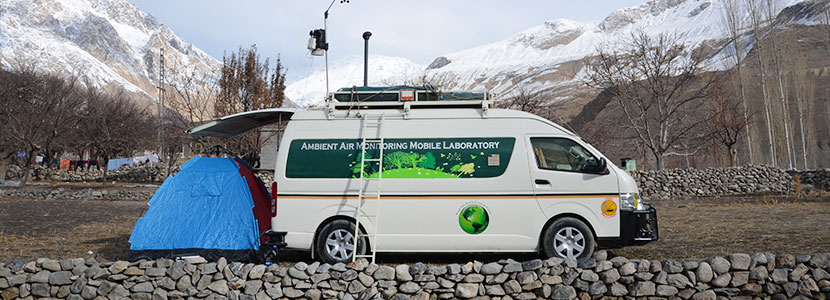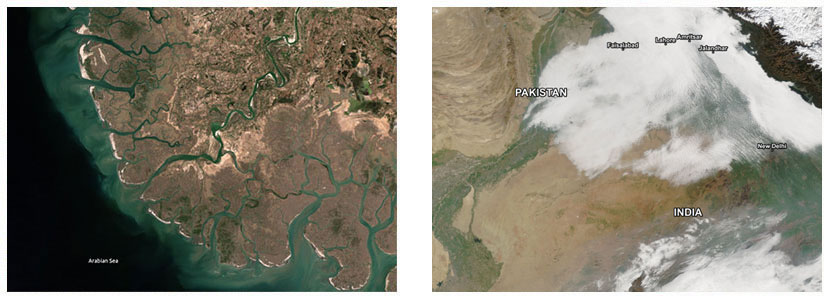Environment

Space based technologies such as remote sensing data have enhanced human understanding of environment. Remote sensing data provides unique capability to assess environmental impacts. Important areas of application are;
- Environmental monitoring (air, sea and land)
- Water quality monitoring
- Fog and aerosol monitoring
- Air pollution
- Dispersion modeling
- Monitor coastal zone ecosystem
- Marine pollution
- Land degradation & erosion modeling

Satellite Data Receiving and Processing Centre
Satellite data from Geostationary (MT SAT, GOMS, Meteosat, FENGYUN-2C) as well as Polar orbiting environmental satellites (NOAA, AQUA/TERRA, Envi. Landsat) is acquired for:
- Aerosol and Gaseous Components (AOD, BC, Hg, O3, SOx, NOx, CO2 etc)
- Atmospheric Profiles (Total-ozone burden in tropospheric and stratospheric ozone content)
- Water Quality (DO, Alpha Chlorophyll, Phosphorus, Turbidity etc.)
- Glacier and Climate Change (snow cover, glacial extent, glacial hazards)
- Marine and Coastal Studies, Droughts
- Biomass assessment (surface biomass)
Environmental Laboratories
SUPARCO maintains two types of environmental laboratories
- Ambient Air Monitoring Mobile Laboratory
- Environmental Chemistry Laboratory
Ambient Air Monitoring Mobile Laboratories
The Ambient Air Monitoring Mobile Laboratories are equipped with Real Time Air Analyzers for
- Carbon dioxide (CO2)
- Carbon monoxide (CO)
- Oxides of Sulfur (SOX)
- Oxides of Nitrogen (NOX)
- Ground level Ozone (O3)
- Black Carbon (BC)
- Gaseous Mercury
- Particulate Matter (TSP, PM10, PM5)
Environmental Chemistry Laboratory
The analytical equipment available in laboratory are:
- Inductively Coupled Plasma Mass Spectrometer (ICP-MS)
- Gas Chromatography Mass Spectrometer (GC-MS)
- Ion Chromatograph
- Carbon-Hydrogen-Nitrogen-Sulfur-Oxygen Analyzer (CHNS-O)
- pH Meter / Conductivity Meter
- Turbidity meter
- COD / BOD Analyzers
- UV-Vis Spectrometer
- Asbestos Microscope
- Microwave Digestion Oven
- Fume hood / Biosafety Cabinet
Mathematical Modeling Center
Mathematical model simulations are applied in R&D as well as commercial projects for short range dispersions from stacks, long-range boundary transport as well as source reception for air parcels. Following models are commonly utilized:
- AERMOD Atmospheric Dispersion Model
- CALPUFF Atmospheric Dispersion Model
- HYSPLITT Model
Microgravity Experiments Facility
In a microgravity environment, there are some factors which influence the behavior of substances e.g., absence of buoyancy and sedimentation, absence of convection and absence of hydrostatic pressure. Thus, conducting the experiments in a microgravity environment has the potential for discoveries that can both improve life on earth and advance our understanding of space. A clinostat is a device in which samples are rotated to prevent them from perceiving the gravitational acceleration vector. Different configurations exist with respect to the number of rotation axes, the speed, and the direction of rotation. Clinostats with one rotation axis, which runs perpendicular to the direction of the gravity vector, are called 2-D clinostats. Clinostats with two axes are called three-dimensional (3-D) clinostats. SUPARCO is pursuing research studies on vegetable plants using both 2-D and 3-D clinostat facilities. These facilities are also available for researchers & students desirous to conduct novel experiments in space environment.
